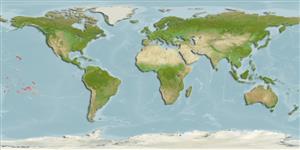Preferred temperature (Ref.
123201): 25.1 - 29, mean 27.9 °C (based on 148 cells).
Phylogenetic diversity index (Ref.
82804): PD
50 = 0.5005 [Uniqueness, from 0.5 = low to 2.0 = high].
Bayesian length-weight: a=0.00759 (0.00398 - 0.01446), b=3.21 (3.05 - 3.37), in cm total length, based on LWR estimates for this species & Genus-body shape (Ref.
93245).
ຊັ້ນເຂດຮ້ອນ (Ref.
69278): 3.4 ±0.5 se; based on size and trophs of closest relatives
ຄວາມຢືດຢຸ່ນ (Ref.
120179): ສູງ, ປະຊາກອນຕຳ່ສຸດທີ່ໃຊ້ເວລາສອງໜ້ອຍກວ່າ 15 ເດືອນ (Preliminary K or Fecundity.).
Fishing Vulnerability (Ref.
59153): Low to moderate vulnerability (32 of 100).
Nutrients (Ref.
124155): Calcium = 215 [83, 511] mg/100g; Iron = 1.53 [0.62, 3.71] mg/100g; Protein = 18.2 [15.6, 20.5] %; Omega3 = 0.236 [0.095, 0.691] g/100g; Selenium = 10.4 [4.0, 28.9] μg/100g; VitaminA = 16.2 [3.8, 75.1] μg/100g; Zinc = 1.12 [0.69, 1.87] mg/100g (wet weight);
